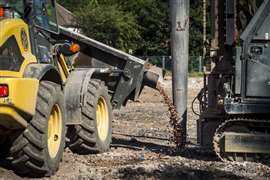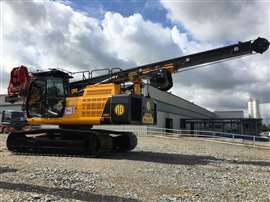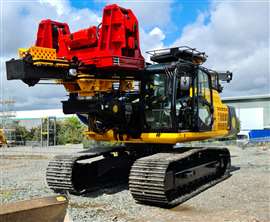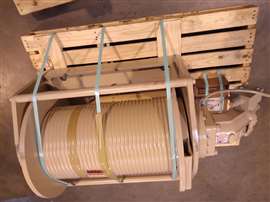How piling innovations and custom engineering are shaping construction
04 November 2024
The construction industry places high value on purpose-built equipment designed for efficiency and reliability. Post-Covid, equipment manufacturers and operators emerged with heightened awareness over a global push toward sustainability and the necessity of manufacturing supply chain resilience.
 Vibro piling rigs use vertical vibrations to drive piles into the ground, reducing soil disturbance and spoil generation for improved site efficiency and productivity goals.
Vibro piling rigs use vertical vibrations to drive piles into the ground, reducing soil disturbance and spoil generation for improved site efficiency and productivity goals.
The growing demands in piling and ground improvement stem from the expansion of infrastructure and construction, both globally and locally. Urbanisation, industrial activities, and the need for stable foundations across all ground conditions are driving this market.
The connection between piling machine durability, reduced downtime, and environmental awareness is becoming increasingly evident. Where hoists are used, requirements for power, speed, precision and reliability intersect.
For OEMs, sourcing durable components is integral, not just for operational performance but also for meeting environmental, social, and corporate governance (ESG) standards.
The global piling machine market exceeded US$5 billion in 2023, with a projected annual growth rate of 4.2% through 2030, according to Grandview Research. Renewable energy projects, such as wind, solar, and geothermal are key drivers of this growth as sustainable energy impacts commercial and residential construction.
Construction attitudes are shifting away from inefficient, pollutant-heavy methods. There’s an increased focus on improving site efficiency, reducing energy use, and cutting emissions, driven by rising costs, stricter regulations, and environmental pressures.
In 2023, the UK-based Federation of Piling Specialists (FPS) introduced a sustainability charter to support carbon reduction and broader ESG practices. The charter sets minimum standards for members, covering both site operations and corporate practices.
The international sustainability forum Construction21 recently drew a connection between environmental impact and unplanned downtime that can result from equipment maintenance issues.
Extended projects may affect surface-level and atmospheric pollution as a larger window is created for potential runoff or habitat degradation. Staying competitive necessitates avoiding environmental and regulatory pitfalls and at the same time mitigating time and cost overruns.
Pressures on piling contractors
 Roger Bullivant Limited manufactures machines such as the new 4500 Vibro Piling Rig, pictured, for use in piling and ground improvement applications.
Roger Bullivant Limited manufactures machines such as the new 4500 Vibro Piling Rig, pictured, for use in piling and ground improvement applications.
Piling contractors face rising pressure to optimise site efficiency while reducing waste and maximising installation flexibility, optimising methods for improving ground stabilisation and enhancing the geotechnical properties of weak soils.
Different methods are employed to address soil quality, depth, and load demands with techniques such as vibro stone columns, rotary bored drilling, and continuous helical displacement selected based on specific site conditions and project requirements.
Piling rigs are intricate machines that must be engineered to apply substantial force with great precision. Operators depend on equipment tailored to meet specific site requirements, environmental regulations, local ordinances, and productivity needs.
The draw to vibro stone columns in sectors such as commercial building and residential dwelling construction is their ability to enhance soil density and strength, minimise the risk of spreading contaminants, and produce zero spoil.
This can be ideal for weak and made-ground conditions in need of increased soil load-bearing capacity, helping mitigate settlement issues and expediting consolidation, particularly useful for projects involving contaminated soil.
Relying on productivity
Roger Bullivant, a construction industry specialist, manufactures machines for use in their own piling and ground improvement applications. They sought an engineered solution to solve hoist component performance and reliability issues that had resulted in lost hours and decreased velocity in the field.
Post-pandemic manufacturing labour supply chain issues had been attributed to fluctuating parts availability and production delays. To form up a solution, Roger Bullivant Limited partnered with Koppen & Lethem, a UK-based hydraulic equipment developer and distributor of Paccar Winch products, including Braden winches and hoists.
Koppen & Lethem worked closely with the piling machine manufacturer to design a custom bi-directional hoist system tailored to their specifications and requirements, facilitating a thorough needs assessment and collaboration among engineering teams. They set out to re-envision a bi-directional piling hoist with a fixed loop design where the cables are securely anchored at both ends – to ensure precision positioning and consistently efficient operation.
This approach was supported by detailed images of Roger Bullivant equipment and unique hoist setup. Design and operational challenges were highlighted, alongside clear expectations for quality assurance and parts and production capabilities that would support high-duty cycle machine performance, site efficiency, and component longevity.
To meet these demands, Braden engineered a variation of their CH210A to create a bi-directional ‘looping’ hoist with 21,000 lb of first layer line pull. One part of the line reels in while the other reels out, for advanced control and drilling head manipulation. The new system was integrated into Roger Bullivant Limited’s 4500 Vibro Piling machine, significantly improving precision, productivity, and component durability.
According to Gavin Davies, General Manager at Koppen & Lethem, the focus was on creating a reliable solution that could withstand the high demands of the market. “Increasing productivity is king,” he noted, emphasising the importance of precision and performance in piling operations.
Dual cable enabled
 Piling rigs are engineered to apply substantial force with great precision. Where hoists are used, requirements for power, speed, precision and reliability intersect.
Piling rigs are engineered to apply substantial force with great precision. Where hoists are used, requirements for power, speed, precision and reliability intersect.
Braden CH Series hoists are designed to withstand the demanding conditions of heavy construction operations with an overrunning clutch and sealed, high-efficiency planetary reduction gearing for continuous-duty performance.
The new CH210A hoist variation features a loop system with cables securely anchored at both ends, ensuring precise positioning and consistent operation.
Compared to a standard 200 bar specification, the hoist engineered to the piling machine OEM’s vibro piling rig spec can handle higher operating pressures, working in conjunction with a piston motor that can operate at 300 bar. This allows for greater force when driving or extracting piles in dense or challenging soil conditions.
The hoist’s design is said to ensure more control over the equipment, reducing downtime and improving site efficiency. The system can better utilise higher strength wire ropes and has been designed for improved service life at higher RPM and higher input torque.
“The CH210 loop winch was a difficult specification,” Davies said. “One part of the cable is going over the top and mounted on the top and one is mounted from below, it can be pulled up and down.”
“Piling is a competitive market sector, value for money is crucial,” he continued. “What we came up with is to mount the cables on both ends inside the hoist drum. The drum was grooved as rope management was crucial.”
The real cost of unplanned downtime
When construction equipment fails, it not only increases the cost of ownership but also extends project timelines. Prolonged projects can lead to negative environmental consequences, such as increased emissions and runoff, while also affecting perceptions of the company’s sustainability profile.
According to Aberdeen Strategy & Research, the average cost of downtime across industries was estimated at $260,000 per hour in 2016, which is equivalent to roughly $340,000 per hour today, adjusted for inflation. Reducing downtime helps cut labor costs, boost site efficiency, and reduce carbon footprints, aligning with ESG goals.
Techniques such as vibro stone piling that produce no spoil and can help mitigate construction site pollutant runoff, boosting site efficiencies and bolstering ecological conservation, have experienced important developments in recent decades.
Performance optimisation in hoist components plays a critical role in mitigating unexpected work stoppages and extending the lifespan of piling equipment.
For OEMs like Roger Bullivant, in a sector where downtime can directly impact environmental and financial outcomes, optimizing manufacturing supply chain relationships, hoist component performance and piling machine reliability could be deemed as essential.
“In the 1970s and 80s, across industries in the UK and I suspect more worldwide, there used to be rooms full of engineers,” Davies said. “A person who looks after winches, there was a hydraulics team, an electronics team.
 A variation of the BRADEN CH 210A, a bi-directional “looping” hoist, was engineered to meet Roger Bullivant Limited’s application requirements.
A variation of the BRADEN CH 210A, a bi-directional “looping” hoist, was engineered to meet Roger Bullivant Limited’s application requirements.
“In the small to medium sized OEMs, large engineering departments don’t exist anymore. So, the specialist engineering such as the winch, the hydraulics, the remote control, is carried out by Koppen & Lethem on behalf of the OEM. Everything we do is individualized to the customer. That’s what they expect from us.”
Future of the piling machine market
The piling machine market continues to grow as infrastructure projects requiring dynamic ground improvement and stabilization solutions drive demand for equipment that aligns with construction firms’ sustainability objectives and operational requirements.
Roger Bullivant Limited is already incorporating additional CH210A piling hoists into their fleet of specialty rigs, further enhancing their ground improvement capabilities and improving fuel efficiency.
Andrew Clarke, National Piling Operations Manager, Roger Bullivant Limited, said, “The introduction of the new 4500 Vibro Piling rig is another great addition to our fleet, strengthening our GI department’s capabilities and improving fuel efficiencies and emissions. Therefore, helping us achieve targets in reducing our carbon footprint by 2030.”
Engineering solutions that are custom-tailored to customer needs are a critical piece in a competitive space. By keeping equipment operational and avoiding unnecessary delays, construction companies can meet ESG targets while bolstering site productivity.
Todd Razor is a Midwest, US-based storyteller covering industry people and trends in construction, manufacturing, and material handling technologies worldwide.
MAGAZINE
NEWSLETTER
CONNECT WITH THE TEAM






